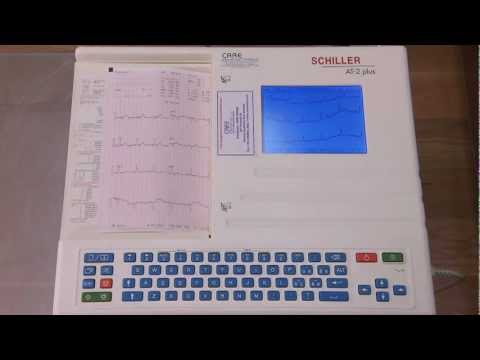What Every EKG Medical Assistant Needs to Know
Contents
If you work as an EKG medical assistant it is important to have a strong understanding of how to read and interpret EKG results. This blog post will provide you with everything you need to know about EKGs, from how to prepare for an EKG test to how to read the results.
Checkout this video:
EKG Medical assistants an overview
EKG Medical Assistants are vital members of the healthcare team. They provide essential support to physicians and other medical professionals in the diagnosis and treatment of cardiovascular conditions.
EKG medical assistants must be able to interpret and troubleshoot electrocardiograms (EKGs), Holter monitor readings, and stress test results. They also perform a variety of other duties, such as scheduling appointments, obtaining patient medical histories, and providing education and support to patients and their families.
EKG medical assistants must have a thorough understanding of physiology and cardiac anatomy, as well as knowledge of Medical Terminology They must be able to work well under pressure, multitask, and communicate effectively with patients, physicians, and other members of the healthcare team.
The basics of EKG
An electrocardiogram, or EKG, is a test that measures the electrical activity of your heart. The test is quick, painless, and easy to tolerate. It’s also noninvasive, meaning that it doesn’t involve any needles or injections.
An EKG can be used to detect a variety of heart conditions, such as a heart attack, an irregular heartbeat, or heart failure. It can also be used to monitor the effects of certain medications on your heart.
During an EKG, sensors are placed on your chest and connected by wires to an EKG machine. The sensors measure the electrical impulses generated by your heart and transmit them to the machine, which displays them on a monitor.
Most EKGs take less than five minutes to complete. In some cases, you may need to have a follow-up test called a Holter monitor test, which is similar to an EKG but is done over a period of 24 hours or longer.
EKG machines and how they work
An EKG machine is used to create an electrocardiogram, which is a record of the electrical activity of the heart. The machine uses sensors that are placed on the chest and arms to pick up this electrical activity and then displays it on a screen. The machine may also print out a copy of the electrocardiogram for the doctor to review.
EKG machines are used to diagnose heart conditions and to monitor the heart’s electrical activity during surgery. They can also be used to check for problems with the heart after a heart attack or other cardiac event.
How to prepare patients for an EKG
An electrocardiogram (EKG/ECG) is a diagnostic tool that measures and records the electrical activity of the heart. This test is used to detect heart abnormalities, such as irregular heart rhythms, heart attacks, and other heart problems.
EKGs can be performed in a doctor’s office, hospital, or clinic. The procedure is quick and easy, and it generally does not cause any discomfort. However, some patients may feel anxious about having the test.
Here are some tips on how to prepare your patients for an EKG:
1. Explain the purpose of the test.
Make sure your patient understands why they are having the test and what it will involve. This will help them to feel more relaxed and cooperative during the procedure.
2. Explain the procedure in detail.
Walk your patient through the steps of the procedure so that they know what to expect. Let them know that you will be attaching electrodes to their chest and that they will need to lie still during the test.
3. Help them to relax.
Some patients may feel anxious about having an EKG. Help them to relax by providing reassurance and support throughout the procedure. You can also offer to hold their hand if they wish.
4. Make sure they are comfortable.
Position your patient comfortably on the examination table before starting the procedure. Make sure they are lying flat on their back with their arms at their sides. If they have any pain or discomfort, let them know so that you can adjust their position accordingly
How to administer an EKG
An electrocardiogram is a test that measures the electrical activity of your heart to show how well it’s working. An EKG is also called an ECG or a cardiac monitor.
For the test, sensors (called electrodes) are placed on your chest and sometimes your limbs. The sensors are connected by wires to an EKG machine, which records your heart’s electrical activity on graph paper or a computer screen.
The test is usually done in a doctor’s office, hospital, or other health care facility. It’s painless and takes only a few minutes.
How to read an EKG
In order to properly care for patients, every medical assistant needs to know how to read an EKG. An EKG is a test that measures the electrical activity of the heart. It is used to detect heart problems, such as arrhythmias and heart attacks.
An EKG machine produces a tracing of the electrical activity of the heart. This tracing is then printed out on paper. The tracing is made up of different waves and complexes. The waves represent different parts of the heartbeat, and the complexes represent different phases of the cardiac cycle.
The first wave on an EKG tracing is the P wave. The P wave represents the depolarization of the atria, or upper chambers, of the heart. The P wave is followed by the QRS complex. The QRS complex represents the depolarization of the ventricles, or lower chambers, of the heart. The QRS complex is followed by the T wave, which represents repolarization of the ventricles.
Medical assistants need to be able to identify each wave and complex on an EKG tracing in order to properly interpret it. In addition, medical assistants need to be familiar with basic dysrhythmias, or abnormal heart rhythms. Dysrhythmias can be caused by a variety of factors, such as electrolyte imbalances, medications, and underlying medical conditions. Knowing how to identify dysrhythmias on an EKG tracing is essential for providing proper patient care.
What do abnormal EKG readings mean?
An EKG reading measures the electrical activity of your heart and can be used to diagnose heart conditions. The test is noninvasive and is usually performed as an outpatient procedure.
EKG readings can be abnormal for a number of reasons, including heart attack, heart disease, and arrhythmia. If you have an abnormal EKG reading, it’s important to follow up with your doctor to determine the cause.
EKG medical assistant career outlook
So you want to be an EKG medical assistant? You’re in luck. The career outlook for this position is very positive. According to the Bureau of Labor Statistics, the demand for medical assistants is expected to grow much faster than the average for all occupations between now and 2026. And as baby boomers age, the need for health services will continue to increase.
EKG medical assistants are in high demand because they perform both administrative and clinical tasks, freeing up nurses and doctors to see more patients. They are a vital part of the healthcare team.
If you’re thinking about a career as an EKG medical assistant, here are a few things you need to know:
An EKG medical assistant is a medical assistant who specializes in performing electrocardiograms (EKGs).
EKGs are used to diagnose heart conditions and problems with the electrical activity of the heart.
To become an EKG medical assistant, you will need to complete a Medical Assistant program that includes training in EKG procedures.
Most employers will also require you to be certified as a Medical Assistant by passing the Certified Medical Assistant (CMA) exam or the Registered Medical Assistant (RMA) exam.
Once you have completed your training and passed your certification exams, you will be ready to start your career as an EKG medical assistant!
EKG medical assistant salary
In order to become an EKG medical assistant, you will need to have a high school diploma or equivalent. There are many online and offline training programs available that can give you the skills and knowledge you need to perform this job. Once you have completed your training, you will be able to take the certification exam offered by the American Registry of Medical Assistants (ARMA).
The average salary for an EKG medical assistant is $32,000 per year. However, salaries can vary depending on experience, location, and other factors.
EKG medical assistant training
EKG medical assistants are responsible for performing electrocardiograms, which are tests that check the heart’s electrical activity. They also may collect patient medical histories, measure vital signs and administer medications. To become an EKG medical assistant, you will need to complete a formal training program. Some community colleges and technical schools offer programs specifically in EKG technology, while other programs may combine training in EKG technology with other aspects of medical assisting.






